●大標題●
快速安裝 NOVELL SERVER 模擬器
圖文.我本善良(asako@parzival.org)
●前言●
Novell server一直是筆者認為最佳的dos下的server,相信台灣目前很多的中小企業
還是會發現它的存在,除了與dos的高相容性之外,ipx/spx傳輸速度也是可取之處,更
重要的是novell server相當的穩定,提供了dos最佳的file server的平台,如果公司
還有用dos的應用程式或者是不想被novell的使用人數綁住的話。不彷在linux上裝個
novell server 模擬器,讓linux也能提供dos平台的檔案伺服器的能力。
●本文●
基本上mars_nwe是RedHat的標準套件,當您第一次在安裝時有選擇IPX/Netware(tm)
Connectivity就會把mars_nwe給安裝進去,如果您當時沒有安裝的話,那也沒有關係,
請放入您RedHat的光碟,並把光碟片mount起來,更換目錄到RedHat光碟裡的RPM目錄,
執行rpm -ivh mars-nwe???就安裝完成了,不過在我們開始設定mars_new時我們必需確
認一下核心程式是否有支援ipx,也就是
The IPX protocol (CONFIG_IPX) [N/m/y/?] y
Full internal IPX network (CONFIG_IPX_INTERN) [N/y/?] n
這兩個選項必需要一樣,mars_new才能夠正確的動作,一般以RedHat的linux通常都會
把ipx編成module,所以只要您沒有自行校調過核心,一般都不用再重新編譯核心,但
是如果您以前作過的話,那就得確認後再自行判斷是否該重編核心一次。
# =========================================================================
# Section 1: volumes (required)
#
# In this section you list all Linux-directories accessible via "mars_nwe".
#
# To be more precise: a mapping from Linux-directories to mars_nwe-volumes
# is done. (Volumes are the beasts you can map to drive letters under DOS
# using "map.exe").
#
# Linux-directory mars_nwe-volume map.exe DOS-Drive
# /var/local/nwe/SYS -------> SYS -------------> W:
#
# More than one entry is allowed in this section.
# The maximum number of volumes is a compile-time option that must be
# specified in `config.h' before compiling mars_nwe.
#
# Please note that at least the volume "SYS" must be defined and it must
# contain the following sub-directories: LOGIN, PUBLIC, SYSTEM, MAIL.
# See the installation-instructions in the doc-directory for more infos.
#
#
# -------------------------------------------------------------------------
# Syntax:
# 1 VOLUMENAME DIRECTORY OPTIONS
#
# VOLUMENAME: the name of the mars_nwe-volume (max. 8 characters)
# DIRECTORY: the directory on your Linux-system associated with that
# volume; use the special name "~" to refer to the users
# individual home-directory
#
# OPTIONS: none or some of the following characters (without a
seperator)
# k allow lowercase-filenames (if you don't set this, all
# files _must_ be upper-case)
# m removable volume (e.g. cd-roms)
# r volume is read-only and always reports "0 byte free"
# (this is intended for copies of CD-ROMs on harddisks)
# o volume has only one filesystem/device/namespace
# this is for filesystems with high inode > 0xFFFFFFF.
# because for namespace services mars_nwe normally use the
# first 4 bit of 32 bit inode for distinguish
# between several devices/namespaces for one volume.
# p "PIPE"-filesystem. All files are pipe commands.
# See `doc/PIPE-FS'.
#
# O + OS/2 namespace.
# N + NFS namespace.
# -------------------------------------------------------------------------
#
# Examples:
# 1 SYS /var/local/nwe/SYS k
# 1 HOME ~ k
# Use /var/netware for the SYS volume, and make it read-only
# 使用linux的/var/mars_new/sys的目錄當作系統的主目錄,也就是說任何的client連
上來之後都在這個目錄下活動,包含讀取檔案或寫入# 檔案,而rk的意義為,這個目錄
設定為只能讀取,並允許小寫的檔案名稱。
1 SYS /var/mars_nwe/sys rk
#再使用linux的/mnt/cdrom當作系統的另一個volume,其中m的意義為可移動式
volume。
1 CDROM /mnt/cdrom kmr
# 1 SYS /u3/SYS/ k
# =========================================================================
# Section 2: servername (optional)
#
# The servername is the name under which this server will show up when
# using tools like "slist" (server-list).
#
# If you don't supply an entry for this section, the hostname of your
# Linux-machine will be converted to all-uppercase and used as the
servername.
#
# -------------------------------------------------------------------------
# Syntax:
# 2 SERVERNAME
#
# SERVERNAME: a name for this nw-server
# -------------------------------------------------------------------------
#
# Example:
#檔案伺服器的名稱,如果您的網路上有另一台novell server時您必需選擇一個不同的
名稱以便區別,而且登入伺服器時必需指定您要登入#的伺服器,才能正確的連接到伺
服器,如果您沒有指定伺服器名稱的話,client端會自行抓取回應最快的伺服器。
# 2 MARS # name of the server would be "MARS"
# 2 SOPHIE
# =========================================================================
# Section 3: Number of the internal network (required)
#
# If have dealt with the TCP/IP-configuration of your Linux-Box, the term
# "ip-address" may be familiar to you. It's a numer that uniquely
# identifies your machine in the internet.
# As you might already expect, even the IPX-people use a unique number to
# identify each other. Addresses in the IPX-world always consist of a
# 4-byte "network-number" plus a 6-byte "node-number" (remember the
# ip-addresses also use 4-bytes).
#
# The numbering-rule for ipx-clients is easy: their "address" is the
# external-network of the server they are connected to plus the
# hardware-address of their own ethernet-card (6 byte). As a result of this
# rule, the clients can determine their address automatically (by listening
# to the server and looking at their own ethernet-hardware) and no
# configuration-files on the clients-side have to be maintained. (It would
# really be a nasty thing if you think of very many DOS-clients [remember:
# DOS is an OS where ordinary users can screw up the configuration files].)
#
# For internal routing purposes, a netware-server has an "internal network"
#
# As there is no organisation which regulates the use of network-numbers
# in the IPX-world, you have to run "slist" (under DOS or Linux) to
# determine a number that isn't already used by another server on your
# net. You better double-check and ask the other network administrators
# before using a random value because not all servers might be on-line when
# you "listen" to the net.
#
# A reasonable choice for the internal net-number of your mars_nwe-server
# could be the ip-address of your Linux-Box. It is reasonable because
# ip-addresse are unique and if every nw-administrator uses only this uniqe
# value, potential conflicts will be minimized. Of course this choice is
# no guarantee.
#
# Please note that you have to specify the address of your "internal
# ipx-network" in hexadecimal format (the leading "0x" indicates it).
#
#
# -------------------------------------------------------------------------
# Syntax:
# 3 INTERNAL_NET [NODE]
#
# INTERNAL_NET: the hexadecimal value of your "internal ipx-network". Use
# "0x0" or "auto" to refer to your ip-addresse (it's a kind of
# automagically setup)
# NODE: use "1" if you don't know what this entry is for (optional)
# -------------------------------------------------------------------------
#
# Example:
#
#
#內部網路節點號碼,您可以使用auto的參數讓mars_nwe自動去設定,或者也可以使用
0x12等十六進位的表示法來設定節點號碼。
#這裡要注意的是如果您的網路上還有另一台novell server時您的節點號碼不可為一
樣。
# 3 auto 1 # automatic setup
3 auto 1
# =========================================================================
# Section 4: IPX-devices (strongly recommended)
#
# This section contains information for the ipx-router built into mars_nwe
# and/or the external program "nwrouted".
# Both processes exchange the ipx-packets between your machine and the rest
# of the world (in other words: their functionallity is essential). Of
# course, to use one of both is already sufficient.
#
# Note for people with other IPX/NCP servers on the net:
# - choose the same frame-type as the other servers use
# - make sure your network-number is not already in use by another
# server (see the output of "slist" under Linux or DOS)
#
# Under Linux, it is possible to let the kernel detect all values
# automatically for you. This is only possible (and only makes sense then)
# if there are other IXP/NCP servers on the same net which are setup
# correctly.
#
#
# -------------------------------------------------------------------------
# Syntax:
# 4 NET_NUMBER DEVICE FRAME TICKS
#
# NET_NUMBER: this number is determined by the router of the physical
# network you're attached to. Use "0x0" to let the
# linux-kernel determine your network number by listening
# on the local network
# DEVICE: the network-interface associated with the NET_NUMBER. Use
# a "*" (star) to automatically setup all devices at once.
# FRAME: the frame-type of the data-packets on your local network.
# Possible values are:
# ethernet_ii
# 802.2
# 802.3 (default)
# snap
# token
# auto automatic detection of the frame-type used
# in your ipx-environment
# TICKS: the time data-packets need to get delivered over a
# certain interface. If your connection goes through several
# routers, the shortest path can be determined by summing up
# all ticks for every route and compare the results.
# (1 tick = 1/18th second)
# -------------------------------------------------------------------------
#
# Examples:
#設定網路編號及其novell框架類型,以novell 3.11版本來說,其內定的框架類型為
802.3,到了3.12版本時就改為802.2了,但是不管在
#novell的標準server或者是mars_nwe都是允許我們自行依照網路的環境去自行設定
的,但其注意的是,如果說您的網路上還有另一台
#novell的server時您必需注意到所有的框架類型及其網路號碼必需為一樣,不然是會
有錯誤的訊息會出現在彼此的server裡的。但是筆者
#建議您手動設定此選項,因為有時自動抓還是會抓錯,以下的範例的解釋為讓Linux自
行設定網路號碼,*就是讓Linux對所有網路裝置自
#動設定編號,並使用802.3作為框架類型。
# 4 0x0 * AUTO 1 # automatic setup
# 4 0x10 eth0 802.3 1 # manual setup
# 4 0x10 eth0 802.3 1
4 0x0 * 802.3 1
# =========================================================================
# Section 5: Saving of ipx-routes (required)
#
# This entry controls if the information regarding the ipx-routes should be
# saved beyond the lifetime of the server.
#
# -------------------------------------------------------------------------
# Syntax:
# 5 SAVE_FLAG
#
# SAVE_FLAG:
# 0 don't save routes (default)
# 1 do save routes
# -------------------------------------------------------------------------
#
#是否儲存ipx路由。一般來說如果您開啟了ipx路由,您也必需檢查一下您的route也是
否允許ipx路由。內定值是不儲存的。
5 0
# =========================================================================
# Section 6: version-"spoofing"
#
# Some clients work better if the server tells that it is a 3.11 Server,
# although many calls (namespace services) of a real 3.11 Server are
# missing yet.
# To test the namespace calls, this entry must be set to > 0 and `config.h'
# must be altered before compiling "mars_nwe".
#
# -------------------------------------------------------------------------
# Syntax:
# 6 SERVER_VERSION
#
# SERVER_VERSION: the version-number reported to DOS-clients
# 0 Version 2.15 (default)
# 1 Version 3.11
# 2 Version 3.12 (not implemented yet)
# -------------------------------------------------------------------------
#
#模擬的版本,內定值為2.15,您也可以使用3.11版,但不建議您使用3.12版
6 0
# =========================================================================
# Section 7: password handling of DOS-clients (required)
#
# When changing your "mars_nwe"-password from a DOS-client, this client
# (think of "LOGIN.EXE", "SYSCON.EXE" or "SETPASS.EXE") can encrypt your
# password before sending it to the "mars_nwe"-server (this improves
# security a little bit).
# In this section you can enforce encryption of user-passwords or allow
# not-encrypted sending of passwords over the net.
#
#
# On the Linux-side, passwords will only be stored in encrypted format.
#
#
# -------------------------------------------------------------------------
# Syntax:
# 7 FLAG
#
# FLAG:
# 0 enforce encryption of _all_ passwords by the DOS-client
# (default)
# 1 as "0", but allow the non-encrypted version of the
# "change password"-routine.
# 7 allow all non-encrypted stuff but no empty nwe passwords.
# 8 allow all non-encrypted stuff and also allow empty
# nwe-passwords.
# 9 use all non-encryted calls + "get crypt key" will allways
fail
# so the login program will use the old unencryted calls.
# this will *not* work with all clients !! (OS2/client)
# -------------------------------------------------------------------------
# client端的密碼控制方式。如果不確定您可以使用內定值。
7 0
# 選項8及9目前沒有被使用
# Section 8: currently not used
# Section 9: currently not used
# Section 10: UID and GID with minimal rights
# =========================================================================
#
# When loading the netware-drivers in the "autoexec.bat" of your
# DOS-client, you automatically "attach" to a netware-server.
# As a result, a new drive-letter is accessible under DOS, usally
# containing the programs "login.exe" and "slist.exe".
# Because you haven't logged in, nothing else of the netware-server
# will be visible to you. All actions requested from the DOS-client
# will be done with the following UID and GID on the Linux-side in this
# case.
# To achieve some level of security, the user/group asscociated with
# the UID and GID should only have _read_ rights on the files visible,
# _nothing_ else.
#
# On most Linux-systems, there is a user and group "nobody" defined in
# `/etc/passwd' and `/etc/group'. Use the number of that user/group
# for the following entries.
#
# -------------------------------------------------------------------------
# Syntax:
# 10 GID
# 11 UID
#
# GID numeric number of the group
# UID numeric number of the user
# -------------------------------------------------------------------------
#
# Example:
# 10 65534
# 11 65534
# 登入mars_nwe時的權限設定。當您連上mars_nwe時,dos會指定一個磁碟槽區給您使
用,通常是F:,這此您尚未登入至mars_nwe,但是您
# 必需要有執行login.exe的權限,才能順利的登入至mars_nwe。這裡執行的權限由
linux去設定,以此為例登入時的userid及groupid各為
# 99,也就是說這裡指定的是nobody及nobody的權限,所以這時您的login.exe的權限
至以要有755才能被執行,工作站也才能夠順利的登入
# 至mars_nwe中。
10 99
11 99
# =========================================================================
# Section 12: supervisor-login (required)
#
# The "supervisor" of a nw-server is much like "root" on the Linux-side.
#
# Specify a Linux-user that should be mapped to the supervisor of this
# mars_nwe-server.
# To improve security, don't use "root" for this purpose but create a
# seperate administrative account (under Linux) called "nw-adm" or similar.
#
# The nw-user defined in this section will have the mars_nwe internal UID
# "1" (remember even under Linux "root" must have the special UID "0"), so
# it is not possible to define a supervisor in section 13 (the users
# defined there will get random UIDs).
# You _can_ define a user with name "SUPERVISOR" in section 13, but he
# won't really be the "local god" on the "mars_nwe"-server.
# And of course you _can_ define a supervisor with name "GOD" or "ROOT"
# in _this_ section, which would only break the traditional naming-scheme
# of the netware-world.
#
#
# -------------------------------------------------------------------------
# Syntax:
# 12 NW_LOGIN LINUX_LOGIN [PASSWORD]
#
# NW_LOGIN: the login-name for the "mars_nwe"-server (traditionally,
# this is "SUPERVISOR")
# LINUX_LOGIN: the account on the Linux-side associated with the NW_LOGIN
# PASSWORD: the password for the NW_LOGIN. It must be clear-text but
# will be encrypted and permanent stored in the
# bindery-files, so it (the password or the whole section, at
# your option) can be deleted after the first start of
"nwserv".
#
# Make sure this file is not world-readable as long
# as the password stands here.
#
# If you leave this field blank when starting "mars_nwe" the
# first time, the supervisor-login will be completely
# disabled. In other words: there is no way to supply the
# supervisor with no password ("null-password").
# -------------------------------------------------------------------------
#
# Example:
# 12 SUPERVISOR nw-adm top-secret
# 在linux中最高的使用者為root而在novell-3.x版中最高的使用者為supervisor,這
項設是mars_nwe的最高使用者的權限,對應至linux的
# 的使用者為何,以此為例,SUPERVISO對應至linux的adm使用者的權限,其登入的密
碼為sophie,這裡請注意的是,密碼不能空白。
12 SUPERVISOR adm sophie
# =========================================================================
# Section 13: user-logins (optional)
#
# You can provide mappings from the regular login-names of your Linux-Box
# to "mars_nwe"-logins here.
# Every "mars_nwe"-user _must_ have a login-name on the Linux side (even
# if he can't log in into the account associated with the login-name,
# because you locked it with a "*") in order to "own" files.
# If you specify a Linux-login that doesn't exist (one could think of a
# typo), the user will only have the minimal rights defined in
# sections 10/11.
#
# See section 12 for a description of the syntax.
#
# Unlike in section 12, you can define users with no password.
#
# Example:
# mars_nwe的帳號與linux的帳號對應,這裡密碼是允許空白的。
# 13 MARTIN martin
# Section 14: currently not used
# =========================================================================
# Section 15: automatic mapping of logins (decision required)
#
# If you have a large number of accounts on your Linux-machine, you may
# want to map all Linux-logins automatically to "mars_nwe"-logins.
#
# At this stage this section is only a quick hack to make life a bit
# easier for the administrator.
#
# WARNING: as there is no algorithm to convert the encrypted
# "Linux-passwords" into the encrypted format used by the DOS-clients (and
# therefore "mars_nwe"), you have to supply a common password for all
# automatically mapped users. This is a big security concern and you
# should never make this common password public (and, of course you
# should choose a sufficient "secure" (read: difficult) password).
# Type the common password to grant access to the users login and the
# command "setpass" instead of telling the password to the user.
#
# Only those Linux-logins will handled automatically that don't have a
# "x" or "*" as their encrypted password.
#
#
# -------------------------------------------------------------------------
# Syntax:
# 15 FLAG DEFAULT_PASSWORD
#
# FLAG:
# 0 DON'T map the Linux-logins automatically to
# "mars_nwe"-logins (default)
# 1 YES, DO the automatic mapping and provide every login
# created this way with the common password given with
# "DEFAULT_PASSWORD"
# 99 re-read the logins from /etc/passwd and overwrite even the
# already existing logins from the bindery (this will also
# reset all the passwords to "DEFAULT_PASSWORD")
#
# DEFAULT_PASSWORD: the common password for all automatically created
# logins (only needed if FLAG is not "0"); everything about
# password in section 12 applies to this.
# -------------------------------------------------------------------------
# flag 0:不對應『內定值』,1:依照系統passwd建立帳戶並統一建立內定密碼以此
為例密碼統一為sophie,使用者可以使用變更密碼
# 的指令更改其密碼,。99:與1一樣但會再啟動時重新讀取passwd,並以起始密碼蓋
過以前已更動的密碼也就是回復所有的密碼為啟始
# 的密碼。
15 1 sophie
# =========================================================================
# Section 16: Tests on startup
#
# If you want some sanity checks at startup, set this flag to 1.
# "mars_nwe" will try to create missing directories (with the "right"
# permissions, of course) if you enable this.
#
# 啟動mars_new是否要檢查系統volume
16 1
# Section 17-20: currently not used
# =========================================================================
# Section 21: print queues (optional)
#
# Which of the printers connected to your Linux-box should be accessible
# from the DOS-clients?
# Multiple entries are allowed.
#
# -------------------------------------------------------------------------
# Syntax:
# 21 QUEUE_NAME QUEUE_DIR PRINT_COMMAND
#
# QUEUE_NAME: the name of the print queue on client-side (to make it
# perfectly clear: _not_ the Linux-queue)
# QUEUE_DIR: spooling directory for the print-jobs; this directory must
# exist before printing (_not_ the spooling-directories of
# the Linux-lpd)
# PRINT_COMMAND: command used for serving the print-jobs under Linux
# (see "man lpr" and "man magicfilter" for details)
#
# Examples:
# 21 LASER SYS:/PRINT/L lpr -Plaser
# 21 OCTOPUSS SYS:/PRINT/O lpr -Php_deskjet
# -------------------------------------------------------------------------
# 印表機伺服器,您可以選擇使用或者是不使用,以此為例LP為佇列名稱,佇列暫存目
錄為SYS:/PRINT/LP,列印指令為lp
21 LP SYS:/PRINT/LP lp
# 以下的參數在一般的裝況下您不需要去修改它,除非您很了解其中所代表的意義。
# --------------------------------------------------------
# You usally don't want to change anything below this line
# --------------------------------------------------------
# Sections 100-106: amount of debug-information
#
# FLAG:
# 0 no debug messages
# 1 errors and notes are reported
# 99 maximum debug levels
100 0 # debug IPX KERNEL (0 | 1)
101 1 # debug NWSERV
102 0 # debug NCPSERV
103 0 # debug NWCONN
104 0 # debug (start) NWCLIENT
105 0 # debug NWBIND
106 1 # debug NWROUTED
# Sections 200-202: logging of "nwserv"
#
200 1 # 0 = no logfile and dont daemonize nwserv/nwrouted
# 1 = daemonize nwserv/nwrouted and use logfile
201 /var/log/mars_nwe.log # filename of logfile
202 0 # 1=creat new logfile, 0=append to logfile
# Sections 210,211: timing
210 5 # 1 .. 600 (default 10) seconds after server
# really goes down after a down command
211 60 # 10 .. 600 (default 60) broadcasts every x seconds
# Sections 300-302: loging of routing-information
300 1 # > 0 print routing info to file every x broadcasts.
# ( normally minutes )
301 /var/run/mars_nwe.routes # filename of logfile
302 1 # 1 = creat new routing info file
# 0 = append to this file
# Section 310: watchdogs
310 7 # send wdog's only to device net < x ticks.
# 0 = allways send wdogs. < 0 = never send wdogs
# Section 400:
# station file for special handling of stations.
400 /etc/nwserv.stations # for syntax see file in the examples directory.
# Section 401: nearest server
#
# for special handling of the 'get nearest server request'.
401 0 # 0 = ignore entry 400, get nearest response ever enabled.
# 1 = 400 are excludes, get nearest response normally
enabled.
# 2 = 400 are includes, get nearest response normally
disabled.
#
到目前為止我們已經設定好mars_nwe的設定工作,不過在起動mars_nwe之前請先insmod
ipx把ipx的模組安裝上去,如果您把ipx給編譯至核心程式裡的話就不用作這個動作,
之後我們到/etc/rc.d/init.d/的目錄裡執行./mars_nwe start,如沒沒有錯誤的話,
執行ps wx的指令您應該可以看到如圖一的畫面,nwserv已經在背景執行。
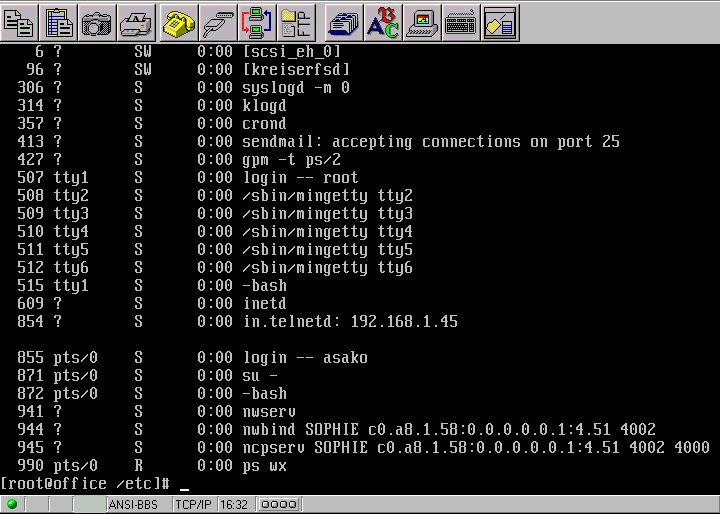 圖一
而且執行ifconfig時您也可以看到如圖二的畫面,其中我們可以看到ipx的
框架類型802.2及802.3都在執行了。
圖一
而且執行ifconfig時您也可以看到如圖二的畫面,其中我們可以看到ipx的
框架類型802.2及802.3都在執行了。
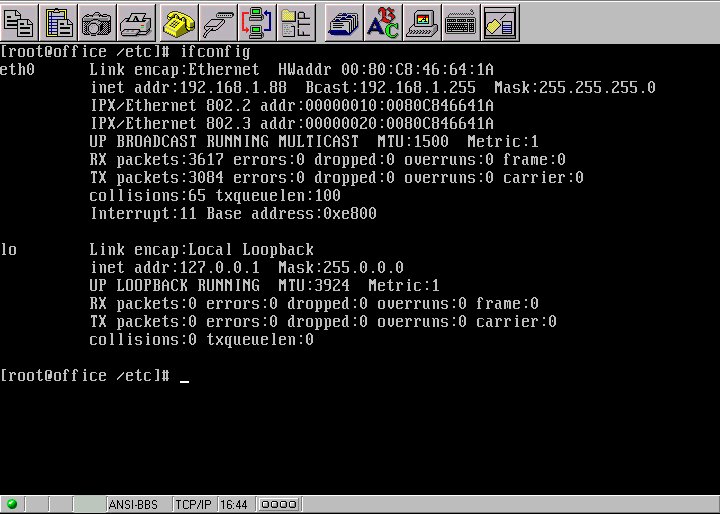 圖二
●DOS工作站連接至mars_nwe●
在mars_new裡並不包含工作站的連線軟體,而且也缺少登入伺服器的程式,還好我們
可以在這裡找到伺服器登入的軟體
ftp://www.compu-art.de/mars_nwe/mars_dosutils-0.17.tgz,只要把這個壓縮檔解開
來,把裡頭的nwnet.exe拷貝至/var/mars_nwe/sys/login/的目 錄下,並且chmod 755
nwnet.exe讓連接的工作站有權利去執行這個程式。再來就是使用網路卡內附的novell
的odi驅動程式來線接至mars_nwe伺服器,使用的步驟通常為一:lsl.com,二:網路卡
驅程式以dlink220為例就是de22x.com,三:ipxodi.com,四:vlm.exe或為netx.exe,
這裡注意的是如果您使用的是vlm.exe時在dos的config.sys裡您必需設定lastdrive=z
這樣才能正確的連線。如果您和筆者一樣有古老的ipxne2.com這類的ne2000網路卡驅動
程式,您也可以直直拿來取用,但是此時就不用在config.sys設定lastdrive=z,不然
也是會出錯的,在這裡筆者以Rtl8019等ne2000相容晶片作示範來連接mars_nwe。
一:第一先用磁片上網路卡的設定程式來設定網路卡的irq及io-prot,這裡筆者設定是
irq=0x3 io-prot=0x300。
二:執行ipxne2.com,如果您設定正確的話,您應可以看到圖三的畫面。
當然您不一定要設定網路下的irq及io為3,300,ipxne2也支援其它的irq及io,您可以
使用ipxne2 /d來看其支援的irq及io各位多少,進而設定您網路下的irq及io。
圖二
●DOS工作站連接至mars_nwe●
在mars_new裡並不包含工作站的連線軟體,而且也缺少登入伺服器的程式,還好我們
可以在這裡找到伺服器登入的軟體
ftp://www.compu-art.de/mars_nwe/mars_dosutils-0.17.tgz,只要把這個壓縮檔解開
來,把裡頭的nwnet.exe拷貝至/var/mars_nwe/sys/login/的目 錄下,並且chmod 755
nwnet.exe讓連接的工作站有權利去執行這個程式。再來就是使用網路卡內附的novell
的odi驅動程式來線接至mars_nwe伺服器,使用的步驟通常為一:lsl.com,二:網路卡
驅程式以dlink220為例就是de22x.com,三:ipxodi.com,四:vlm.exe或為netx.exe,
這裡注意的是如果您使用的是vlm.exe時在dos的config.sys裡您必需設定lastdrive=z
這樣才能正確的連線。如果您和筆者一樣有古老的ipxne2.com這類的ne2000網路卡驅動
程式,您也可以直直拿來取用,但是此時就不用在config.sys設定lastdrive=z,不然
也是會出錯的,在這裡筆者以Rtl8019等ne2000相容晶片作示範來連接mars_nwe。
一:第一先用磁片上網路卡的設定程式來設定網路卡的irq及io-prot,這裡筆者設定是
irq=0x3 io-prot=0x300。
二:執行ipxne2.com,如果您設定正確的話,您應可以看到圖三的畫面。
當然您不一定要設定網路下的irq及io為3,300,ipxne2也支援其它的irq及io,您可以
使用ipxne2 /d來看其支援的irq及io各位多少,進而設定您網路下的irq及io。
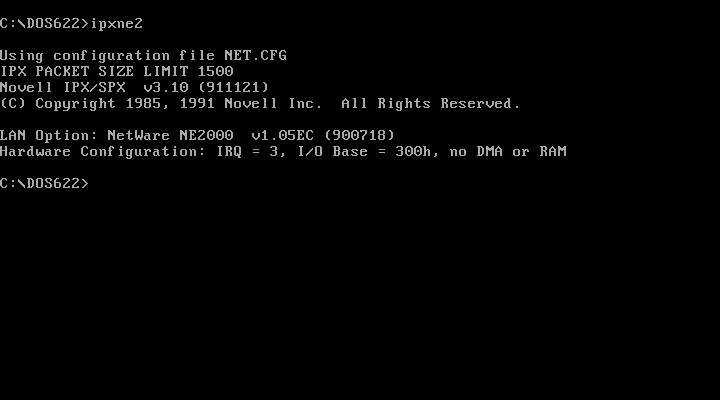 圖三
三:執行netx.exe,您應當可以看到圖四的畫面。
圖三
三:執行netx.exe,您應當可以看到圖四的畫面。
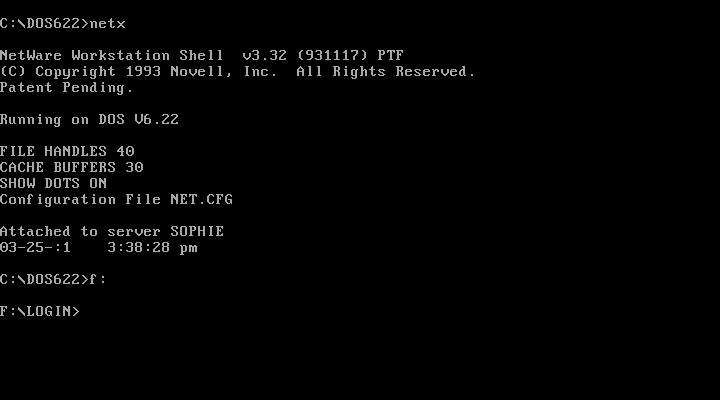 圖四
四:目前您只有連接到mars_nwe的伺服器,您還沒有登入,此時您就必需執行
nwnet.exe這支程式來登入至伺服器中。如圖五所示,我使用最高權限
supervisor來登入如圖六,密碼就是我們剛才設的『asako』
圖四
四:目前您只有連接到mars_nwe的伺服器,您還沒有登入,此時您就必需執行
nwnet.exe這支程式來登入至伺服器中。如圖五所示,我使用最高權限
supervisor來登入如圖六,密碼就是我們剛才設的『asako』
 圖五
圖五
 圖六
五:執行dos的dir指令,您是否看到如圖七的畫面。
圖六
五:執行dos的dir指令,您是否看到如圖七的畫面。
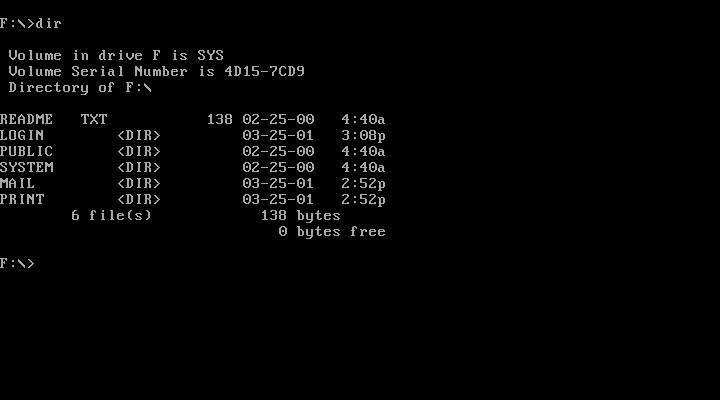 圖七
●nwnet常用指令說明●
語法:nwnet func
funcs:
PASSWD : 變更使用者密碼
LOGOUT : 登出伺服器,如圖八﹕
圖七
●nwnet常用指令說明●
語法:nwnet func
funcs:
PASSWD : 變更使用者密碼
LOGOUT : 登出伺服器,如圖八﹕
 圖八
PATHINS : 插入執行程式搜尋路徑
PATHDEL : 刪除執行程式搜尋路徑
PATH : 顯示或設定搜尋路徑
MAPDEL : 刪除對應磁碟
MAP : 顯示或設定對應磁碟,如圖九:
圖八
PATHINS : 插入執行程式搜尋路徑
PATHDEL : 刪除執行程式搜尋路徑
PATH : 顯示或設定搜尋路徑
MAPDEL : 刪除對應磁碟
MAP : 顯示或設定對應磁碟,如圖九:
 圖九
ENDCAP : 取消列印導向『有novell印表機伺服器才要使用』
CAPTURE : 顯示或設定列印導向 『同上』
LOGIN : 登入伺服器
●Windows9X連接至mars_nwe●
一:以windows98為例,開始==>設定==>控制台==>網路==>新增==>用戶端
==>Microsoft==>Client for Netware Network
二:開始==>設定==>控制台==>網路==>新增==>通訊協定==>Microsoft==>IPX/SPX相容
通訊協定。
三:打開網路上的芳鄰,您就可以看到mars_nwe的伺服器。
●結語●
筆者在某一次的系統規劃案中,幫客戶在同一台Linux伺服器中建立了samba伺服器及
mars_nwe伺服器,並以software-raid的方式建立了一個結合dos及winodws及資料備份
的伺服器,也許有人會問您為何不用ms-client,使dos也可以連上samba,其原因說穿
了很簡單,因為在dos下640k的記憶體是很保貴的,再加上倚天中文,可使用的記憶體
更少,所以我選擇ipx/spx的連線程式用以節省記憶體的使用量,如此而已。當然啦
mars_nwe的應用不只如此,結合ncpfs,ncpmount,更能使用遠端的novell伺服器所開
放出來的資料,掛載至mars_nwe的系統下,還有smart這個web化的mars_nwe的控制程
式,有空時各位不彷試試mars_new的威力。
●附錄●
以上所有的程式您都可以在這個網站的下載區裡找到。http://www.parzival.org/,
並且歡迎各位討論。<目前休站中>
圖九
ENDCAP : 取消列印導向『有novell印表機伺服器才要使用』
CAPTURE : 顯示或設定列印導向 『同上』
LOGIN : 登入伺服器
●Windows9X連接至mars_nwe●
一:以windows98為例,開始==>設定==>控制台==>網路==>新增==>用戶端
==>Microsoft==>Client for Netware Network
二:開始==>設定==>控制台==>網路==>新增==>通訊協定==>Microsoft==>IPX/SPX相容
通訊協定。
三:打開網路上的芳鄰,您就可以看到mars_nwe的伺服器。
●結語●
筆者在某一次的系統規劃案中,幫客戶在同一台Linux伺服器中建立了samba伺服器及
mars_nwe伺服器,並以software-raid的方式建立了一個結合dos及winodws及資料備份
的伺服器,也許有人會問您為何不用ms-client,使dos也可以連上samba,其原因說穿
了很簡單,因為在dos下640k的記憶體是很保貴的,再加上倚天中文,可使用的記憶體
更少,所以我選擇ipx/spx的連線程式用以節省記憶體的使用量,如此而已。當然啦
mars_nwe的應用不只如此,結合ncpfs,ncpmount,更能使用遠端的novell伺服器所開
放出來的資料,掛載至mars_nwe的系統下,還有smart這個web化的mars_nwe的控制程
式,有空時各位不彷試試mars_new的威力。
●附錄●
以上所有的程式您都可以在這個網站的下載區裡找到。http://www.parzival.org/,
並且歡迎各位討論。<目前休站中>
|
 圖一
而且執行ifconfig時您也可以看到如圖二的畫面,其中我們可以看到ipx的
框架類型802.2及802.3都在執行了。
圖一
而且執行ifconfig時您也可以看到如圖二的畫面,其中我們可以看到ipx的
框架類型802.2及802.3都在執行了。
 圖二
●DOS工作站連接至mars_nwe●
在mars_new裡並不包含工作站的連線軟體,而且也缺少登入伺服器的程式,還好我們
可以在這裡找到伺服器登入的軟體
ftp://www.compu-art.de/mars_nwe/mars_dosutils-0.17.tgz,只要把這個壓縮檔解開
來,把裡頭的nwnet.exe拷貝至/var/mars_nwe/sys/login/的目 錄下,並且chmod 755
nwnet.exe讓連接的工作站有權利去執行這個程式。再來就是使用網路卡內附的novell
的odi驅動程式來線接至mars_nwe伺服器,使用的步驟通常為一:lsl.com,二:網路卡
驅程式以dlink220為例就是de22x.com,三:ipxodi.com,四:vlm.exe或為netx.exe,
這裡注意的是如果您使用的是vlm.exe時在dos的config.sys裡您必需設定lastdrive=z
這樣才能正確的連線。如果您和筆者一樣有古老的ipxne2.com這類的ne2000網路卡驅動
程式,您也可以直直拿來取用,但是此時就不用在config.sys設定lastdrive=z,不然
也是會出錯的,在這裡筆者以Rtl8019等ne2000相容晶片作示範來連接mars_nwe。
一:第一先用磁片上網路卡的設定程式來設定網路卡的irq及io-prot,這裡筆者設定是
irq=0x3 io-prot=0x300。
二:執行ipxne2.com,如果您設定正確的話,您應可以看到圖三的畫面。
當然您不一定要設定網路下的irq及io為3,300,ipxne2也支援其它的irq及io,您可以
使用ipxne2 /d來看其支援的irq及io各位多少,進而設定您網路下的irq及io。
圖二
●DOS工作站連接至mars_nwe●
在mars_new裡並不包含工作站的連線軟體,而且也缺少登入伺服器的程式,還好我們
可以在這裡找到伺服器登入的軟體
ftp://www.compu-art.de/mars_nwe/mars_dosutils-0.17.tgz,只要把這個壓縮檔解開
來,把裡頭的nwnet.exe拷貝至/var/mars_nwe/sys/login/的目 錄下,並且chmod 755
nwnet.exe讓連接的工作站有權利去執行這個程式。再來就是使用網路卡內附的novell
的odi驅動程式來線接至mars_nwe伺服器,使用的步驟通常為一:lsl.com,二:網路卡
驅程式以dlink220為例就是de22x.com,三:ipxodi.com,四:vlm.exe或為netx.exe,
這裡注意的是如果您使用的是vlm.exe時在dos的config.sys裡您必需設定lastdrive=z
這樣才能正確的連線。如果您和筆者一樣有古老的ipxne2.com這類的ne2000網路卡驅動
程式,您也可以直直拿來取用,但是此時就不用在config.sys設定lastdrive=z,不然
也是會出錯的,在這裡筆者以Rtl8019等ne2000相容晶片作示範來連接mars_nwe。
一:第一先用磁片上網路卡的設定程式來設定網路卡的irq及io-prot,這裡筆者設定是
irq=0x3 io-prot=0x300。
二:執行ipxne2.com,如果您設定正確的話,您應可以看到圖三的畫面。
當然您不一定要設定網路下的irq及io為3,300,ipxne2也支援其它的irq及io,您可以
使用ipxne2 /d來看其支援的irq及io各位多少,進而設定您網路下的irq及io。
 圖三
三:執行netx.exe,您應當可以看到圖四的畫面。
圖三
三:執行netx.exe,您應當可以看到圖四的畫面。
 圖四
四:目前您只有連接到mars_nwe的伺服器,您還沒有登入,此時您就必需執行
nwnet.exe這支程式來登入至伺服器中。如圖五所示,我使用最高權限
supervisor來登入如圖六,密碼就是我們剛才設的『asako』
圖四
四:目前您只有連接到mars_nwe的伺服器,您還沒有登入,此時您就必需執行
nwnet.exe這支程式來登入至伺服器中。如圖五所示,我使用最高權限
supervisor來登入如圖六,密碼就是我們剛才設的『asako』
 圖五
圖五
 圖六
五:執行dos的dir指令,您是否看到如圖七的畫面。
圖六
五:執行dos的dir指令,您是否看到如圖七的畫面。
 圖七
●nwnet常用指令說明●
語法:nwnet func
funcs:
PASSWD : 變更使用者密碼
LOGOUT : 登出伺服器,如圖八﹕
圖七
●nwnet常用指令說明●
語法:nwnet func
funcs:
PASSWD : 變更使用者密碼
LOGOUT : 登出伺服器,如圖八﹕
 圖八
PATHINS : 插入執行程式搜尋路徑
PATHDEL : 刪除執行程式搜尋路徑
PATH : 顯示或設定搜尋路徑
MAPDEL : 刪除對應磁碟
MAP : 顯示或設定對應磁碟,如圖九:
圖八
PATHINS : 插入執行程式搜尋路徑
PATHDEL : 刪除執行程式搜尋路徑
PATH : 顯示或設定搜尋路徑
MAPDEL : 刪除對應磁碟
MAP : 顯示或設定對應磁碟,如圖九:
 圖九
ENDCAP : 取消列印導向『有novell印表機伺服器才要使用』
CAPTURE : 顯示或設定列印導向 『同上』
LOGIN : 登入伺服器
●Windows9X連接至mars_nwe●
一:以windows98為例,開始==>設定==>控制台==>網路==>新增==>用戶端
==>Microsoft==>Client for Netware Network
二:開始==>設定==>控制台==>網路==>新增==>通訊協定==>Microsoft==>IPX/SPX相容
通訊協定。
三:打開網路上的芳鄰,您就可以看到mars_nwe的伺服器。
●結語●
筆者在某一次的系統規劃案中,幫客戶在同一台Linux伺服器中建立了samba伺服器及
mars_nwe伺服器,並以software-raid的方式建立了一個結合dos及winodws及資料備份
的伺服器,也許有人會問您為何不用ms-client,使dos也可以連上samba,其原因說穿
了很簡單,因為在dos下640k的記憶體是很保貴的,再加上倚天中文,可使用的記憶體
更少,所以我選擇ipx/spx的連線程式用以節省記憶體的使用量,如此而已。當然啦
mars_nwe的應用不只如此,結合ncpfs,ncpmount,更能使用遠端的novell伺服器所開
放出來的資料,掛載至mars_nwe的系統下,還有smart這個web化的mars_nwe的控制程
式,有空時各位不彷試試mars_new的威力。
●附錄●
以上所有的程式您都可以在這個網站的下載區裡找到。http://www.parzival.org/,
並且歡迎各位討論。<目前休站中>
圖九
ENDCAP : 取消列印導向『有novell印表機伺服器才要使用』
CAPTURE : 顯示或設定列印導向 『同上』
LOGIN : 登入伺服器
●Windows9X連接至mars_nwe●
一:以windows98為例,開始==>設定==>控制台==>網路==>新增==>用戶端
==>Microsoft==>Client for Netware Network
二:開始==>設定==>控制台==>網路==>新增==>通訊協定==>Microsoft==>IPX/SPX相容
通訊協定。
三:打開網路上的芳鄰,您就可以看到mars_nwe的伺服器。
●結語●
筆者在某一次的系統規劃案中,幫客戶在同一台Linux伺服器中建立了samba伺服器及
mars_nwe伺服器,並以software-raid的方式建立了一個結合dos及winodws及資料備份
的伺服器,也許有人會問您為何不用ms-client,使dos也可以連上samba,其原因說穿
了很簡單,因為在dos下640k的記憶體是很保貴的,再加上倚天中文,可使用的記憶體
更少,所以我選擇ipx/spx的連線程式用以節省記憶體的使用量,如此而已。當然啦
mars_nwe的應用不只如此,結合ncpfs,ncpmount,更能使用遠端的novell伺服器所開
放出來的資料,掛載至mars_nwe的系統下,還有smart這個web化的mars_nwe的控制程
式,有空時各位不彷試試mars_new的威力。
●附錄●
以上所有的程式您都可以在這個網站的下載區裡找到。http://www.parzival.org/,
並且歡迎各位討論。<目前休站中>